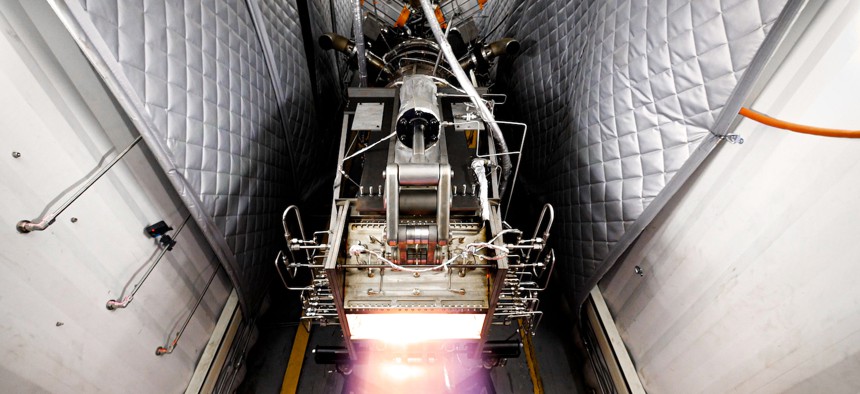Engine Tests Move Hypersonic Aircraft Closer to First Flight
Hermeus’ engine successfully shifted from turbojet to ramjet power during trials at Notre Dame Lab.
Hermeus completed what it said was a major test of a new-design engine, bringing the startup one step closer to building reusable hypersonic aircraft.
During a series of tests at the Notre Dame Turbomachinery Laboratory in Indiana, the company’s engine, called Chimera, switched between turbojet and ramjet power. It’s believed to be the first time a commercial company has accomplished this transition.
“One of the most important milestones to making operational hypersonic flight a reality is this test campaign,” Glenn Case, Hermeus’ chief technical officer, said in an interview. “It is a huge milestone to de-risk our next steps here, and it's really a proof point that small teams can do special things, such as rapidly design, build, and test hardware, with significantly lower budgets than our industry peers.”
Hermeus did the testing over a three-month period and completed the conversion from turbojet to ramjet several times, according to company officials. The trials concluded earlier this week.
Venture-backed Hermeus first appeared on the scene in 2019 with bold plans for hypersonic passenger aircraft. A year later, it won a $1.5 million U.S. Air Force contract to explore how a hypersonic aircraft could be used to fly high-ranking government officials around the world. Since then, it's announced plans to build both military and commercial aircraft. It received tens of millions of dollars more from the Air Force, and its backers now include Raytheon Technologies, parent company of aircraft engine-maker Pratt & Whitney.
Hermeus’ work has also caught the eye of top Pentagon officials. Hermeus was one of a small number of large and small firms that participated in a high-profile meeting with Defense Secretary Lloyd Austin and Deputy Defense Secretary Kathleen Hicks about hypersonic technology.
Hermeus is trying to build the first-ever reusable hypersonic aircraft.
To fly Mach 5, or five times the speed of sound, the plane must rely on two engines that Hermeus engineers have combined. The first is a turbo-jet, which powers the plane at lower speeds, such as during take-off and landing. Using a special cooling method, engineers are able to get the turbojet engine to run hotter and faster. Between Mach 2 and Mach 3, the turbojet transitions to a ramjet engine, which powers the plane at hypersonic speed.
“That's actually pretty tricky and pretty difficult,” Case said.
The switch, which happened over about five seconds in the test, involves a series of doors and valves to reroute the air being sucked into the engines. Around Mach 3, the turbojet shuts down and the aircraft is fully powered by the ramjet. Engineers were able to simulate speeds around Mach 4 during the test.
“I think the most important part of this test campaign was the fact that … not only that we're able to show that transition from gas turbine engine mode to ramjet mode, [but] that we’re able to do it so fast,” Case said.
Hermeus designed the engine, built it, and conducted the test in 21 months. The feat cost $18 million, a small fraction of the cost of typical military projects run by large defense firms.
Part of the reason for the lower cost was that the company’s engineers used an off-the-shelf J85 turbojet. It also used 3D printing for about 15 percent of its engine parts.
“The high-speed stuff, … the inlet, the isolator, the pre-cooler, the forward door that bypasses the air around the engine, all those ducts as well as the RAM burner portion of it and nozzle is all ours,” Case said.
In the coming months, the company plans to do more engine testing while the first aircraft, called Quarterhorse, is built. The plan is to roll out the aircraft next year.
“We're not an airplane company till we start building airplanes,” Case said. We're funded to flight—and we're gonna go fly.”
NEXT STORY: Donated Tanks Headed to Ukraine





